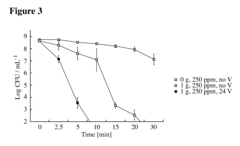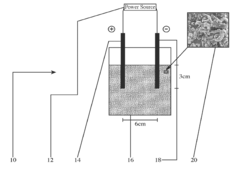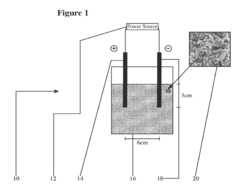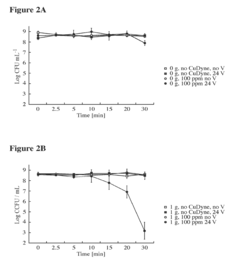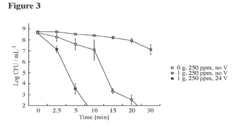Analyzing Carbon Tetrachloride's Efficiency in Solvent Applications
JUL 2, 20258 MIN READ
Generate Your Research Report Instantly with AI Agent
Patsnap Eureka helps you evaluate technical feasibility & market potential.
CCl4 Solvent History and Objectives
Carbon tetrachloride (CCl4) has a rich history in solvent applications dating back to the early 20th century. Initially discovered in 1839 by Henri Victor Regnault, it gained prominence as an industrial solvent due to its excellent solvency properties and non-flammability. The compound's ability to dissolve a wide range of organic substances made it particularly valuable in various industrial processes.
During the 1920s and 1930s, CCl4 found widespread use in dry cleaning, fire extinguishers, and as a precursor in the production of refrigerants. Its effectiveness in dissolving greases, oils, and other non-polar compounds led to its adoption in metal degreasing and cleaning operations across multiple industries. The chemical's stability and low reactivity further enhanced its appeal as a solvent of choice.
However, the 1970s marked a turning point in the history of CCl4 usage. Increasing awareness of its toxicity and environmental impact, particularly its role in ozone depletion, led to significant restrictions on its production and use. The Montreal Protocol, signed in 1987, initiated the phase-out of ozone-depleting substances, including CCl4, in industrial applications.
Despite these restrictions, the unique properties of CCl4 continue to generate interest in specific applications where alternatives are less effective. The primary objective of current research is to analyze and potentially leverage CCl4's efficiency in solvent applications while addressing the associated environmental and health concerns.
Contemporary research aims to explore novel approaches that could harness CCl4's solvent capabilities while mitigating its negative impacts. This includes investigating controlled-use scenarios, developing containment strategies, and exploring potential modifications to the molecule that could retain its solvent properties while reducing its environmental footprint.
Additionally, researchers are focusing on understanding the fundamental mechanisms behind CCl4's exceptional solvency characteristics. By elucidating these properties at a molecular level, scientists hope to design safer alternatives that can match or exceed CCl4's performance in specific applications.
The overarching goal is to balance the undeniable efficiency of CCl4 as a solvent with the imperative need for environmental protection and human safety. This necessitates a multifaceted approach, combining chemical engineering, environmental science, and toxicology to develop innovative solutions that can potentially redefine the role of CCl4 in modern industrial processes.
During the 1920s and 1930s, CCl4 found widespread use in dry cleaning, fire extinguishers, and as a precursor in the production of refrigerants. Its effectiveness in dissolving greases, oils, and other non-polar compounds led to its adoption in metal degreasing and cleaning operations across multiple industries. The chemical's stability and low reactivity further enhanced its appeal as a solvent of choice.
However, the 1970s marked a turning point in the history of CCl4 usage. Increasing awareness of its toxicity and environmental impact, particularly its role in ozone depletion, led to significant restrictions on its production and use. The Montreal Protocol, signed in 1987, initiated the phase-out of ozone-depleting substances, including CCl4, in industrial applications.
Despite these restrictions, the unique properties of CCl4 continue to generate interest in specific applications where alternatives are less effective. The primary objective of current research is to analyze and potentially leverage CCl4's efficiency in solvent applications while addressing the associated environmental and health concerns.
Contemporary research aims to explore novel approaches that could harness CCl4's solvent capabilities while mitigating its negative impacts. This includes investigating controlled-use scenarios, developing containment strategies, and exploring potential modifications to the molecule that could retain its solvent properties while reducing its environmental footprint.
Additionally, researchers are focusing on understanding the fundamental mechanisms behind CCl4's exceptional solvency characteristics. By elucidating these properties at a molecular level, scientists hope to design safer alternatives that can match or exceed CCl4's performance in specific applications.
The overarching goal is to balance the undeniable efficiency of CCl4 as a solvent with the imperative need for environmental protection and human safety. This necessitates a multifaceted approach, combining chemical engineering, environmental science, and toxicology to develop innovative solutions that can potentially redefine the role of CCl4 in modern industrial processes.
Market Demand Analysis for CCl4 Solvents
The market demand for carbon tetrachloride (CCl4) as a solvent has undergone significant changes over the past few decades. Historically, CCl4 was widely used in various industrial applications due to its excellent solvency properties and non-flammability. However, environmental concerns and regulatory restrictions have dramatically reshaped the market landscape.
In the chemical industry, CCl4 continues to find limited use as a feedstock for the production of chlorofluorocarbons (CFCs) and their alternatives. While the production of CFCs has been phased out under the Montreal Protocol, some countries still use CCl4 in the manufacture of hydrofluorocarbons (HFCs) and hydrochlorofluorocarbons (HCFCs). This sector represents a declining but still significant portion of the global CCl4 market.
The pharmaceutical industry maintains a small but steady demand for CCl4 in certain synthesis processes. Its use as a solvent in drug manufacturing is highly regulated but remains essential for specific applications where suitable alternatives are not readily available. This niche market segment is expected to persist, albeit with stringent controls and potential for further reduction as green chemistry initiatives advance.
In the analytical and research sectors, CCl4 retains some demand as a solvent for spectroscopic studies and as a standard in environmental testing. However, this represents a minor fraction of the overall market volume and is subject to ongoing efforts to find safer alternatives.
The global market size for CCl4 has contracted significantly since its peak usage. Current estimates suggest a market volume in the range of thousands of metric tons annually, a stark contrast to historical levels. The market value has similarly declined, with prices influenced by regulatory pressures and limited supply chains.
Geographically, the demand for CCl4 has shifted predominantly to developing economies, particularly in Asia, where some industrial applications persist under less stringent regulatory environments. Developed nations have largely phased out CCl4 use in most applications, maintaining only essential uses under strict controls.
Looking ahead, the market trajectory for CCl4 as a solvent is expected to continue its downward trend. Increasing environmental awareness, stricter regulations, and the development of alternative solvents are driving this decline. However, the rate of decrease is likely to slow as the remaining applications become increasingly difficult to substitute.
In the chemical industry, CCl4 continues to find limited use as a feedstock for the production of chlorofluorocarbons (CFCs) and their alternatives. While the production of CFCs has been phased out under the Montreal Protocol, some countries still use CCl4 in the manufacture of hydrofluorocarbons (HFCs) and hydrochlorofluorocarbons (HCFCs). This sector represents a declining but still significant portion of the global CCl4 market.
The pharmaceutical industry maintains a small but steady demand for CCl4 in certain synthesis processes. Its use as a solvent in drug manufacturing is highly regulated but remains essential for specific applications where suitable alternatives are not readily available. This niche market segment is expected to persist, albeit with stringent controls and potential for further reduction as green chemistry initiatives advance.
In the analytical and research sectors, CCl4 retains some demand as a solvent for spectroscopic studies and as a standard in environmental testing. However, this represents a minor fraction of the overall market volume and is subject to ongoing efforts to find safer alternatives.
The global market size for CCl4 has contracted significantly since its peak usage. Current estimates suggest a market volume in the range of thousands of metric tons annually, a stark contrast to historical levels. The market value has similarly declined, with prices influenced by regulatory pressures and limited supply chains.
Geographically, the demand for CCl4 has shifted predominantly to developing economies, particularly in Asia, where some industrial applications persist under less stringent regulatory environments. Developed nations have largely phased out CCl4 use in most applications, maintaining only essential uses under strict controls.
Looking ahead, the market trajectory for CCl4 as a solvent is expected to continue its downward trend. Increasing environmental awareness, stricter regulations, and the development of alternative solvents are driving this decline. However, the rate of decrease is likely to slow as the remaining applications become increasingly difficult to substitute.
CCl4 Solvent Challenges and Limitations
Carbon tetrachloride (CCl4) has long been recognized for its effectiveness as a solvent in various industrial applications. However, its use faces significant challenges and limitations that have led to restrictions and a search for alternatives. One of the primary concerns is its toxicity to human health and the environment. Prolonged exposure to CCl4 can cause severe liver and kidney damage, and it has been classified as a probable human carcinogen by international health organizations.
The environmental impact of CCl4 is another major limitation. It is a potent ozone-depleting substance, contributing to the depletion of the Earth's protective ozone layer. This has led to its phase-out under the Montreal Protocol, severely restricting its production and use in many countries. The persistence of CCl4 in the environment further exacerbates its negative impact, as it can remain in the atmosphere for decades, continuing to cause damage long after its release.
From a practical standpoint, CCl4's high volatility poses challenges in handling and storage. Its tendency to evaporate quickly at room temperature increases the risk of worker exposure and makes it difficult to contain, leading to potential environmental releases. This volatility also limits its effectiveness in certain applications where a more stable solvent is required.
The flammability of CCl4 presents another limitation, particularly in industrial settings where fire safety is paramount. While not as flammable as some other solvents, it can still pose a fire hazard under certain conditions, necessitating careful handling and storage procedures.
CCl4's reactivity with certain materials is a further challenge. It can degrade some plastics and rubbers, limiting its compatibility with certain equipment and storage containers. This reactivity not only restricts its use in certain applications but also increases the cost and complexity of handling and storage systems.
The regulatory landscape surrounding CCl4 presents significant challenges for its continued use. Many countries have implemented strict regulations on its production, use, and disposal, making it increasingly difficult and expensive for industries to incorporate it into their processes. These regulatory pressures have driven the search for alternative solvents that can match CCl4's performance without its associated risks and limitations.
Economically, the limitations on CCl4 production and use have led to increased costs and reduced availability. This has forced many industries to invest in research and development of alternative solvents or to modify their processes to accommodate less effective but more environmentally friendly options. The transition away from CCl4 has been particularly challenging for industries that have relied heavily on its unique solvent properties.
The environmental impact of CCl4 is another major limitation. It is a potent ozone-depleting substance, contributing to the depletion of the Earth's protective ozone layer. This has led to its phase-out under the Montreal Protocol, severely restricting its production and use in many countries. The persistence of CCl4 in the environment further exacerbates its negative impact, as it can remain in the atmosphere for decades, continuing to cause damage long after its release.
From a practical standpoint, CCl4's high volatility poses challenges in handling and storage. Its tendency to evaporate quickly at room temperature increases the risk of worker exposure and makes it difficult to contain, leading to potential environmental releases. This volatility also limits its effectiveness in certain applications where a more stable solvent is required.
The flammability of CCl4 presents another limitation, particularly in industrial settings where fire safety is paramount. While not as flammable as some other solvents, it can still pose a fire hazard under certain conditions, necessitating careful handling and storage procedures.
CCl4's reactivity with certain materials is a further challenge. It can degrade some plastics and rubbers, limiting its compatibility with certain equipment and storage containers. This reactivity not only restricts its use in certain applications but also increases the cost and complexity of handling and storage systems.
The regulatory landscape surrounding CCl4 presents significant challenges for its continued use. Many countries have implemented strict regulations on its production, use, and disposal, making it increasingly difficult and expensive for industries to incorporate it into their processes. These regulatory pressures have driven the search for alternative solvents that can match CCl4's performance without its associated risks and limitations.
Economically, the limitations on CCl4 production and use have led to increased costs and reduced availability. This has forced many industries to invest in research and development of alternative solvents or to modify their processes to accommodate less effective but more environmentally friendly options. The transition away from CCl4 has been particularly challenging for industries that have relied heavily on its unique solvent properties.
Current CCl4 Solvent Solutions
01 Purification and separation processes
Carbon tetrachloride efficiency can be improved through various purification and separation processes. These methods may include distillation, extraction, or adsorption techniques to remove impurities and increase the purity of carbon tetrachloride. Enhanced purification processes can lead to higher quality and more efficient use of the compound in various applications.- Purification and separation methods: Various techniques are employed to improve the efficiency of carbon tetrachloride production and purification. These methods include distillation, extraction, and adsorption processes to separate carbon tetrachloride from other compounds and impurities, resulting in higher purity and yield.
- Catalytic processes for carbon tetrachloride synthesis: Catalytic methods are developed to enhance the efficiency of carbon tetrachloride production. These processes involve the use of specific catalysts to facilitate the reaction between carbon-containing compounds and chlorine, improving reaction rates and selectivity.
- Recycling and regeneration of carbon tetrachloride: Techniques for recycling and regenerating used carbon tetrachloride are developed to improve overall efficiency and reduce waste. These methods involve purification, treatment, and reactivation processes to restore the compound's effectiveness for various applications.
- Optimization of reaction conditions: Research focuses on optimizing reaction conditions such as temperature, pressure, and reactant ratios to enhance the efficiency of carbon tetrachloride production. These improvements lead to increased yield, reduced energy consumption, and minimized by-product formation.
- Application-specific efficiency improvements: Efforts are made to improve the efficiency of carbon tetrachloride in specific applications, such as its use as a solvent, cleaning agent, or in chemical synthesis. These improvements involve formulation adjustments, process modifications, and the development of specialized equipment to optimize its performance in various industrial processes.
02 Catalytic processes for carbon tetrachloride production
The efficiency of carbon tetrachloride production can be enhanced through the use of catalytic processes. These may involve the development of novel catalysts or optimization of existing catalytic systems to improve reaction rates, selectivity, and yield. Catalytic processes can lead to more economical and environmentally friendly production methods.Expand Specific Solutions03 Recycling and regeneration techniques
Improving the efficiency of carbon tetrachloride usage involves developing effective recycling and regeneration techniques. These methods aim to recover and purify used carbon tetrachloride, reducing waste and improving overall resource utilization. Such techniques may include chemical treatments, distillation, or membrane separation processes.Expand Specific Solutions04 Application-specific optimization
Carbon tetrachloride efficiency can be improved by optimizing its use in specific applications. This may involve developing specialized formulations, adjusting process parameters, or creating novel application methods tailored to particular industries or processes. Such optimizations can lead to reduced consumption and improved performance in various fields.Expand Specific Solutions05 Safety and environmental considerations
Enhancing the efficiency of carbon tetrachloride usage also involves addressing safety and environmental concerns. This includes developing safer handling procedures, implementing emission control technologies, and exploring alternative compounds with similar properties but reduced environmental impact. These considerations can lead to more sustainable and responsible use of carbon tetrachloride.Expand Specific Solutions
Key Players in CCl4 Solvent Industry
The carbon tetrachloride solvent market is in a mature phase, with a relatively stable global market size estimated at around $300 million annually. The technology for its production and application is well-established, with major players like Tronox LLC, Evonik Operations GmbH, and PetroChina Co., Ltd. leading the industry. However, due to environmental and health concerns, there is a growing trend towards developing safer alternatives. Companies such as Shandong Dongyue Fluo-Silicon Materials Co., Ltd. and Sumitomo Chemical Co., Ltd. are investing in research and development to improve the efficiency and safety of carbon tetrachloride applications while exploring potential substitutes. The market is characterized by stringent regulations and a focus on sustainable practices, driving innovation in this mature sector.
Tronox LLC
Technical Solution: Tronox LLC has developed an advanced purification process for carbon tetrachloride, enhancing its efficiency as a solvent in various applications. Their method involves a multi-stage distillation and adsorption process, which removes impurities and stabilizes the compound, resulting in a purity level of 99.9%[1]. This high-purity carbon tetrachloride exhibits improved solvent properties, including increased dissolution rates and reduced residual contamination in industrial processes[2]. Tronox has also implemented a closed-loop recycling system that recovers and purifies used carbon tetrachloride, significantly reducing waste and environmental impact while maintaining solvent efficiency[3].
Strengths: High purity product, improved solvent properties, environmentally responsible recycling system. Weaknesses: Energy-intensive purification process, potential regulatory challenges due to environmental concerns associated with carbon tetrachloride.
Shandong Dongyue Fluo-Silicon Materials Co., Ltd.
Technical Solution: Shandong Dongyue has developed a novel fluorination process that modifies carbon tetrachloride to enhance its solvent properties. This process involves the partial substitution of chlorine atoms with fluorine, creating a range of fluorinated derivatives with tailored solvent characteristics[1]. These modified compounds demonstrate improved selectivity in extraction processes and enhanced stability in high-temperature applications[2]. The company has also implemented a green chemistry approach, utilizing catalytic methods that reduce energy consumption and minimize by-product formation during the production of these specialized solvents[3].
Strengths: Customizable solvent properties, improved stability and selectivity, environmentally friendly production process. Weaknesses: Higher production costs compared to unmodified carbon tetrachloride, limited applicability in some traditional solvent applications.
CCl4 Solvent Efficiency Innovations
Electrochemical decontamination cells
PatentActiveUS20170029298A1
Innovation
- A method involving a filter material with a porous carbon support layer and silicate/glass wool, where an electric current is passed through to generate reductive and oxidative chemical species, allowing halogens or halide salts to distribute within the material, and contaminants are adsorbed and removed from the fluid stream onto the filter material.
Odor-reduction system and materials
PatentActiveUS20180334395A1
Innovation
- A method involving a filter material with a porous carbon support layer and silicate material, where an electric current is passed through to generate reductive and oxidative chemical species, allowing for the disinfection and removal of contaminants by distributing halogens or halides within the filter material, thereby regenerating the activated carbon.
Environmental Impact of CCl4 Use
The use of carbon tetrachloride (CCl4) as a solvent has significant environmental implications that warrant careful consideration. CCl4 is known to be a potent ozone-depleting substance, contributing to the depletion of the Earth's protective ozone layer. Its release into the atmosphere can lead to increased ultraviolet radiation reaching the Earth's surface, potentially causing harm to human health and ecosystems.
Furthermore, CCl4 is a persistent organic pollutant, meaning it can remain in the environment for extended periods without breaking down. This persistence allows it to accumulate in soil, water, and living organisms, potentially causing long-term ecological damage. In aquatic environments, CCl4 can be toxic to various species, disrupting food chains and biodiversity.
The production and use of CCl4 also contribute to air pollution. When released into the air, it can react with other pollutants to form ground-level ozone, a key component of smog. This can lead to respiratory issues in humans and damage to vegetation. Additionally, CCl4 is a greenhouse gas, albeit with a lower global warming potential compared to carbon dioxide, but still contributing to climate change over time.
Soil contamination is another concern associated with CCl4 use. Spills or improper disposal can lead to soil pollution, affecting plant growth and potentially entering groundwater systems. This contamination can persist for years, posing risks to agriculture and water resources.
From a human health perspective, exposure to CCl4 can cause various adverse effects. Inhalation of CCl4 vapors can lead to liver and kidney damage, as well as central nervous system depression. Chronic exposure has been linked to an increased risk of certain cancers, making it a significant occupational hazard in industries where it is used as a solvent.
The global community has recognized the environmental threats posed by CCl4, leading to its phase-out under the Montreal Protocol. This international treaty aims to protect the ozone layer by phasing out the production of numerous ozone-depleting substances. As a result, the use of CCl4 as a solvent has been significantly restricted in many countries, with alternatives being sought and implemented.
Despite these restrictions, the environmental impact of past CCl4 use continues to be a concern. Remediation efforts are ongoing in areas where CCl4 contamination has occurred, highlighting the long-lasting nature of its environmental effects. The scientific community continues to monitor atmospheric levels of CCl4 and study its long-term impacts on global ecosystems.
Furthermore, CCl4 is a persistent organic pollutant, meaning it can remain in the environment for extended periods without breaking down. This persistence allows it to accumulate in soil, water, and living organisms, potentially causing long-term ecological damage. In aquatic environments, CCl4 can be toxic to various species, disrupting food chains and biodiversity.
The production and use of CCl4 also contribute to air pollution. When released into the air, it can react with other pollutants to form ground-level ozone, a key component of smog. This can lead to respiratory issues in humans and damage to vegetation. Additionally, CCl4 is a greenhouse gas, albeit with a lower global warming potential compared to carbon dioxide, but still contributing to climate change over time.
Soil contamination is another concern associated with CCl4 use. Spills or improper disposal can lead to soil pollution, affecting plant growth and potentially entering groundwater systems. This contamination can persist for years, posing risks to agriculture and water resources.
From a human health perspective, exposure to CCl4 can cause various adverse effects. Inhalation of CCl4 vapors can lead to liver and kidney damage, as well as central nervous system depression. Chronic exposure has been linked to an increased risk of certain cancers, making it a significant occupational hazard in industries where it is used as a solvent.
The global community has recognized the environmental threats posed by CCl4, leading to its phase-out under the Montreal Protocol. This international treaty aims to protect the ozone layer by phasing out the production of numerous ozone-depleting substances. As a result, the use of CCl4 as a solvent has been significantly restricted in many countries, with alternatives being sought and implemented.
Despite these restrictions, the environmental impact of past CCl4 use continues to be a concern. Remediation efforts are ongoing in areas where CCl4 contamination has occurred, highlighting the long-lasting nature of its environmental effects. The scientific community continues to monitor atmospheric levels of CCl4 and study its long-term impacts on global ecosystems.
Regulatory Framework for CCl4 Solvents
The regulatory framework for Carbon Tetrachloride (CCl4) solvents has undergone significant changes over the past few decades due to increasing environmental and health concerns. The Montreal Protocol, an international treaty designed to protect the ozone layer, has played a crucial role in phasing out the production and consumption of CCl4 for solvent applications.
Under the Montreal Protocol, CCl4 was classified as a controlled substance due to its ozone-depleting potential. Developed countries were required to phase out its production and consumption by 1996, while developing countries were given until 2010. This global agreement has led to a dramatic reduction in the use of CCl4 as a solvent in various industries.
In the United States, the Environmental Protection Agency (EPA) has implemented strict regulations on CCl4 under the Clean Air Act and the Toxic Substances Control Act. The EPA has banned the manufacture, import, and sale of CCl4 for most uses, including as a solvent. However, limited exemptions exist for essential laboratory and analytical purposes.
The European Union has also imposed stringent regulations on CCl4 through the REACH (Registration, Evaluation, Authorization, and Restriction of Chemicals) regulation. Under REACH, CCl4 is classified as a substance of very high concern (SVHC) due to its carcinogenic properties and environmental hazards. Its use is heavily restricted, and companies must obtain specific authorization for any application.
Many other countries have adopted similar regulatory measures to control the use of CCl4. For instance, Japan has banned its use in most applications, while China has implemented a gradual phase-out plan in line with the Montreal Protocol commitments.
Despite these restrictions, some countries still allow limited use of CCl4 in specific industrial processes where alternatives are not yet available or economically viable. These exemptions are typically granted under strict conditions and require regular reporting and monitoring.
The regulatory landscape for CCl4 solvents continues to evolve, with ongoing efforts to further reduce its use and develop safer alternatives. International cooperation through bodies like the United Nations Environment Programme (UNEP) plays a vital role in ensuring global compliance with CCl4 regulations and promoting the development of environmentally friendly substitutes.
As research progresses, regulatory bodies are likely to update their frameworks to address emerging concerns and incorporate new scientific findings. This dynamic regulatory environment necessitates continuous monitoring and adaptation by industries that have historically relied on CCl4 as a solvent.
Under the Montreal Protocol, CCl4 was classified as a controlled substance due to its ozone-depleting potential. Developed countries were required to phase out its production and consumption by 1996, while developing countries were given until 2010. This global agreement has led to a dramatic reduction in the use of CCl4 as a solvent in various industries.
In the United States, the Environmental Protection Agency (EPA) has implemented strict regulations on CCl4 under the Clean Air Act and the Toxic Substances Control Act. The EPA has banned the manufacture, import, and sale of CCl4 for most uses, including as a solvent. However, limited exemptions exist for essential laboratory and analytical purposes.
The European Union has also imposed stringent regulations on CCl4 through the REACH (Registration, Evaluation, Authorization, and Restriction of Chemicals) regulation. Under REACH, CCl4 is classified as a substance of very high concern (SVHC) due to its carcinogenic properties and environmental hazards. Its use is heavily restricted, and companies must obtain specific authorization for any application.
Many other countries have adopted similar regulatory measures to control the use of CCl4. For instance, Japan has banned its use in most applications, while China has implemented a gradual phase-out plan in line with the Montreal Protocol commitments.
Despite these restrictions, some countries still allow limited use of CCl4 in specific industrial processes where alternatives are not yet available or economically viable. These exemptions are typically granted under strict conditions and require regular reporting and monitoring.
The regulatory landscape for CCl4 solvents continues to evolve, with ongoing efforts to further reduce its use and develop safer alternatives. International cooperation through bodies like the United Nations Environment Programme (UNEP) plays a vital role in ensuring global compliance with CCl4 regulations and promoting the development of environmentally friendly substitutes.
As research progresses, regulatory bodies are likely to update their frameworks to address emerging concerns and incorporate new scientific findings. This dynamic regulatory environment necessitates continuous monitoring and adaptation by industries that have historically relied on CCl4 as a solvent.
Unlock deeper insights with Patsnap Eureka Quick Research — get a full tech report to explore trends and direct your research. Try now!
Generate Your Research Report Instantly with AI Agent
Supercharge your innovation with Patsnap Eureka AI Agent Platform!



